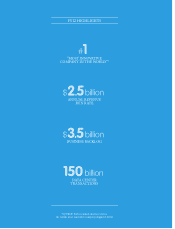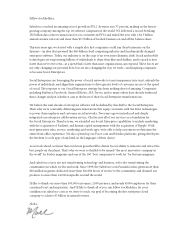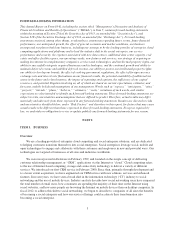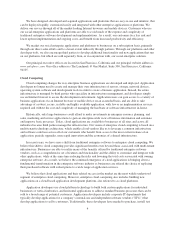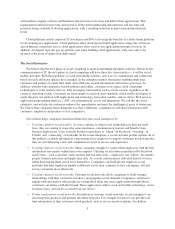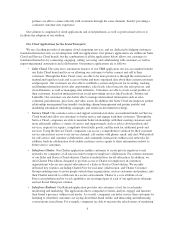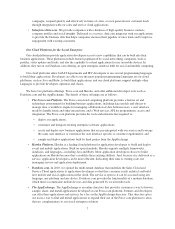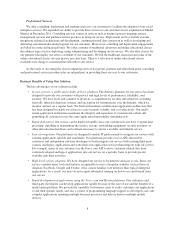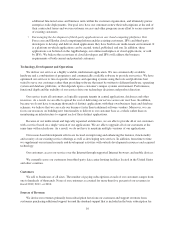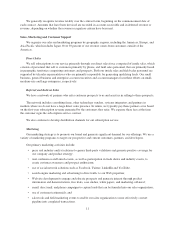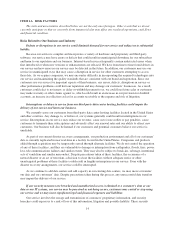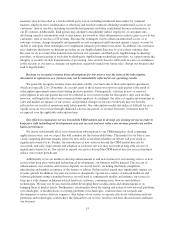Salesforce.com 2012 Annual Report Download - page 9
Download and view the complete annual report
Please find page 9 of the 2012 Salesforce.com annual report below. You can navigate through the pages in the report by either clicking on the pages listed below, or by using the keyword search tool below to find specific information within the annual report.and maintain complex software and hardware infrastructure to develop and deliver their applications. This
requirement resulted in more time and resources being spent maintaining infrastructure and less time and
resources being available to develop applications, with a resulting reduction in innovation and productivity
levels.
Cloud platforms enable corporate IT developers and ISVs to leverage the benefits of a multi-tenant platform
for developing new applications. Cloud platforms allow developers to build applications using only a browser
and an Internet connection, just as cloud applications allow users to use applications through a browser. In
addition, developers typically pay no upfront costs when building cloud applications, with costs only to be
incurred at the point of application deployment.
The Social Enterprise
We believe that the next phase of cloud computing is again transforming enterprise software. Driven by the
consumerization of IT, the next phase of cloud computing will have three key characteristics – it will be social,
mobile and open. With the popularity of social networking websites, new ways to communicate and collaborate
based on feeds and status updates have emerged. In the enterprise market, that means enabling employees,
customers and partners to easily find, share and collaborate around information and business processes. In
addition, with the wide adoption of mobile phones and tablets, customers now expect cloud computing
technologies to work on these devices, fully leveraging functionality such as touch-screens, regardless of the
carrier or operating system. Customers are increasingly focused on open standards, which enable developers to
easily integrate our solution with applications and technology from other vendors, and we offer a Web services
application programming interface (“API”) for programmatic access and integration. We call this the social
enterprise, and we help our customers embrace the opportunities and meet the challenges it poses to businesses.
We believe that companies must change the way they collaborate, communicate and share information with
customers, employees and partners to stay competitive.
Our solution helps companies transform themselves into social enterprises by:
•Creating customer social profiles: As users continue to adopt social technologies in their personal
lives, they are coming to expect the same experience, communication features and benefits from
business applications. Users want the business equivalents of “liking” on Facebook, “tweeting” on
Twitter, and “connecting” on LinkedIn. In the social enterprise, a social customer profile captures all of
this publicly available information, empowering every employee to support customers by knowing who
they are and delivering a new and comprehensive level of service and experience.
•Creating employee social networks: Many companies struggle to connect their employees with the best
information and experts within their own company. Utilizing social features popularized by Facebook
and Twitter – such as profiles, status updates and real-time feeds – employees can “follow” documents,
people, business processes and application data. As a result, information is delivered directly to users,
rather than making them search for it themselves. Companies can build private employee social
networks that help employees rapidly collaborate across their company so they can engage, sell and
service customers more effectively.
•Creating customer social networks: Customer social networks allow companies to build stronger
relationships with their customers on today’s most popular social channels. Companies can listen to,
engage with and analyze what people are saying about them and create applications through which
customers can interact with their brand. These applications utilize social and mobile technology, can be
location-aware, and can be accessed from any device.
•Product and partner social networks: In addition to customer social networks, social enterprises can
also bring their products and partners into these networks. For example, businesses can provide real-
time information to their customers about products, such as service needs or updates. In addition,
5


